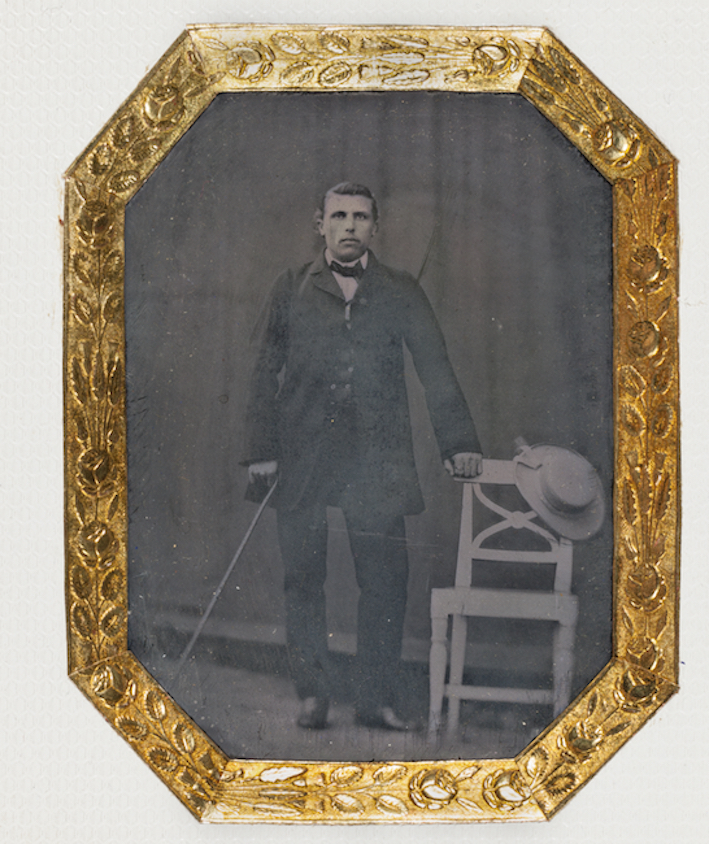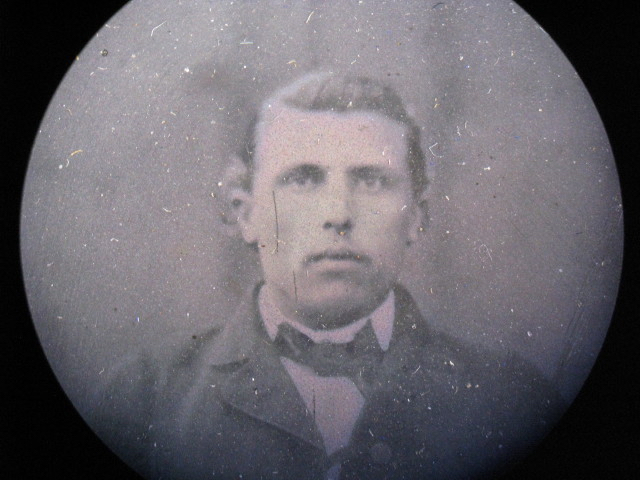19th-century silver picture – daguerrotype
While organising the image archive of the Serlachius Museums some old-looking photographs were found. On their manufacturing technology, themes and origin could only be speculated. I knew that G. A. Serlachius, the founder of the Mänttä mill, had been active in the business of photography in Tampere and I presumed the accompanying image might be a daguerreotype taken by him.
I took the image and three other images to Finnish Museum of Photography to be examined by conservators Riitta Koskivirta and Laura Sallas. The darkish image depicts a young man resting his hand lightly against a chair. The details of the image were also studied with a microscope. It revealed that on the man’s left index finger there probably was a professional service ring.
The photograph had a 19th century-style passe-partout, where a decorative golden chamfer borders the image. The protective glass had been taken off. The image proved to be an ambrotype or collodion positive that is a unique original silver picture. Ambrotype is an under-exposed glass negative image, which viewed against a black background appears to be a positive image. The method was used from 1850s to1860s. Almost always the ambrotype is kept in a case or framed under a glass.
Teemu Keskisarja writes that in the early 1860s G. A. Serlachius became an international businessman. He co-operated with Stockmann and got the hang of the conventions in exports and imports. Stockmann became Serlachius’ forwarding agent. It was perhaps through this co-operation that Serlachius became familiar with photography, which was a relatively new line of operation. He ordered photographic equipment from Germany and acted as a business agent of the branch.
It has been presumed that Serlachius had taken the first preserved photographs of Tampere from the year 1863. A photographic studio was attached to the pharmacy operating at the address Kauppatori 3. There Serlachius’ assistant or the principal operator was pharmacist Konstantin Hakulin (Hackulin), who also resided in the pharmacy building. Hakulin worked for Serlachius as a pharmacist from 1859–1868, the years 1862–67 he practised the profession of a photographer. His photograph studio enjoyed high popularity.
Gustaf Ahlberg (Ahlborg) who had been a travelling professional photographer since 1860 hired the pharmacy’s studio in 1867 and continued the business of a photographic studio until next year. Ahlberg was born in Sweden and had been living in Paris, Brussels as well as in Aachen.
Gust. Ahlberg published an advertisement in Tampereen Sanomat 22 October 1867. He recommends all kinds of photographic work, such as portraits, landscapes, copying of oil paintings: ”Good craftsmanship and inexpensive prices, I dare to expect a myriad of clients. The atelier is located at pharmacist Serlachius’ house alongside the market place. Portraits will be taken daily 10am–3 pm in 6–8 seconds on cloudy as well as on bright days”.
For now it still remains unsolved who the man in the picture is and by whom the picture was taken. An educated guess is that it was taken in the studio of the Serlachius’ pharmacy and G. A. Serlachius brought it with him from Tampere to Mänttä. The image was preserved in the ownership of the family and later in the museum’s collections for over 150 years. For a while the ambrotype will remain in the museum of photography to be cleaned and given a necessary protective cover so that it could be preserved at least as long a time as it already has.
Scources:
http://kukakuvasi.valokuvataiteenmuseo.fi
Keskisarja, Teemu 2010, Vihreän kullan kirous. G.A.Serlachiuksen elämä ja afäärit (Curse of the Green Gold, Life and Business Affairs of G. A. Serlachius).
Helena Hänninen
Curator



